Family : Labridae

Text © Giuseppe Mazza

English translation by Mario Beltramini
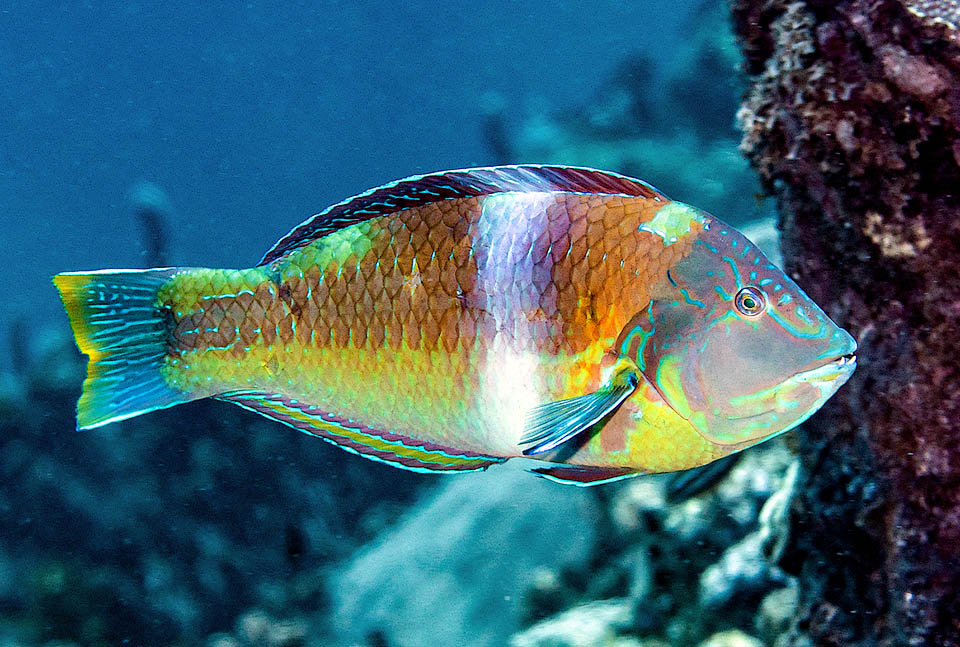
Even half meter long but usually 40 cm, Halichoeres radiatus lives in west Atlantic centered on the Caribbean © www.carlosestape.photoshelter.com
Taxonomically located in the class of the Actinopterygii, the ray-finned fish, and in the order of the Perciformes, the family of the Labridae is present with about 70 genera and 600 species present in almost all seas, in the brackish waters and often also in the aquaria, in plain sight due to its bright and surprising liveries, changeable depending on the emotions and on the age.
They are in fact transformistic fishes that, acting on the chromatophores, the cells of the skin containing the pigments, can change colour instantly such as Lachnolaimus maximus, and that often present youth intermediate and adult liveries, very different from each other like Coris gaimard.
Known in English with the untranslatable name of Puddingwife, and in French as Donzelle arc en ciel, that is Rainbow damsel, Halichoeres radiatus (Linnaeus, 1758) belongs too, with three phases, to this family.
The genus Halichoeres, created by Rüppel in 1835 from the Greek “halios”, sea, and “choiros”, pig, originates from the elongated and protruding from the jaws conical teeth that remind the canines of the wild boars evoking a sea pig, whilst the specific term radiatus, with rays in Latin, is a reference to the characteristic adults’ blue lines placed around the eyes.
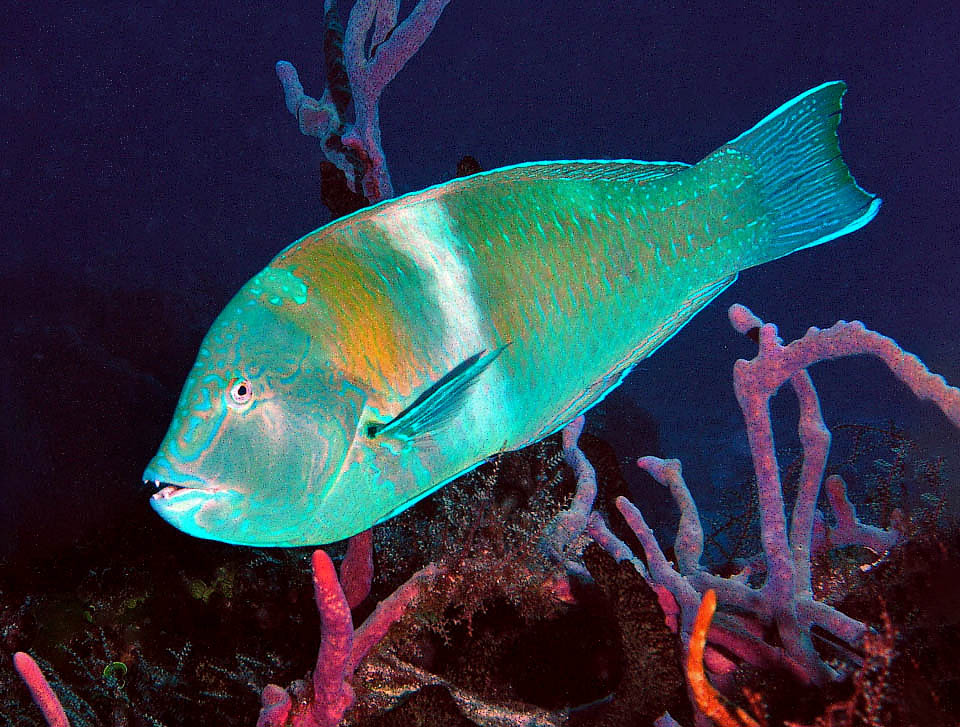
It’s the biggest Atlantic member of the genus Halichoeres that in Greek means sea pig because of its protruding teeth, like a wild boar © Mark Rosenstein
Zoogeography
It is a Caribbean fish of western Atlantic, present from Bermuda and Florida up to the Gulf of Mexico but also in the Brazilian islands of St. Paul’s Rocks, Fernando de Noronha and Atol das Rochas, whilst it is not found along the Brazilian coasts occupied by Halichoeres brasiliensis.
Ecology-Habitat
Halichoeres radiatus moves mainly among the madreporic and rocky formations at 2-55 m in depth, with most sightings between 5 and 45 m, but does not disdain the estuaries and the soft sea bottoms of the sandy beaches or of the mangrove swamps.
Morphophysiology
The body is elongated and laterally compressed with large cycloid scales, absent on the head ending with a protractile mouth having flesh lips. The upper jaw has a couple of canines, the lower two, and we can note some dental shredding plates in the throat.
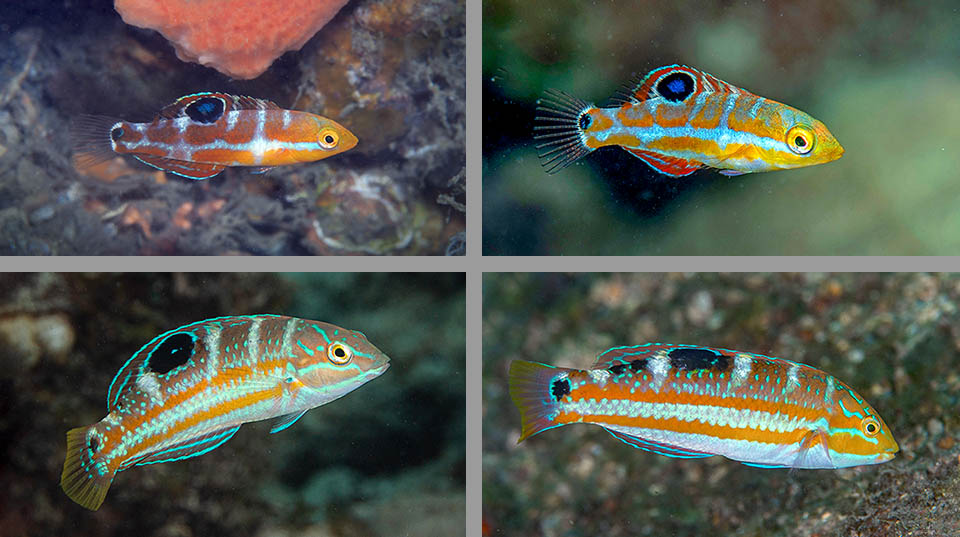
In the livery that changes non-stop growing, 3 important moments are chosen. This is the so-called Juvenile phase with snaps showing its evolution in the time. Up © Pauline Walsh Jacobson and © Frank Krasovec – Down © Tim Cameron and © Frank Krasovec
There is only one dorsal fin with 9 spiny rays and 11 soft; the anal has 3 armed rays and 12 unarmed ones; the pectoral ones 13 rays and the caudal is truncated.
It is the biggest Atlantic species of the genus Halichoeres, and even if the current size is of about 40 cm, the males may reach the length of 51 cm after incredible morphological transformations. In fact the females are sequential hermaphrodites. That is, the female gonads mature earlier than the male ones and therefore upon a certain age they change sex assuming the males authoritative appearance. In this regard we count 3 phases of growth with different liveries.
The juvenile phase begins with a yellow-orange body crossed by a long bluish horizontal clear stripe starting from the eye bound to the tail with 5 branches upwards more or less interrupted. Characteristic is the big black ocellus with blue pupil located between the dorsal fin and the adjacent part of the body, followed by another smaller ocellus at the upper extremity of the tail. Later on, growing, appear the first grey-blue lines around the eyes, sided by a similar stripe under the mouth. Upward, on the sides, their scales get rich in oval small spots of analogous colour and we note two long black dorsal spots preceded and flanked by whitish bars that replace, enlarged, the upper part of the 5 branches of the early times.
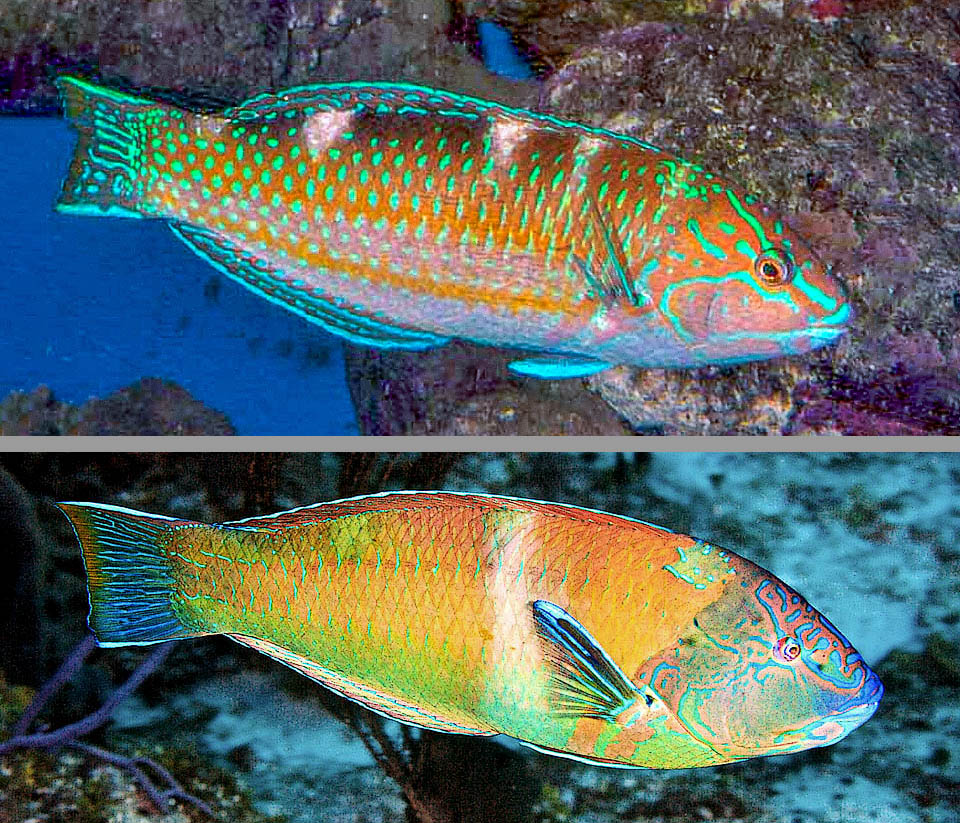
Up here the Initial phase, with the showy oval spots on the scales, and below the Terminal phase with a wide shaded white bar that breaks the body in two © Robertson Ross (above) © www.carlosestape.photoshelter.com (below)
The initial phase catches the eye due to the showy growth of the oval grey greenish blue spots, whilst the fins display blue lines and spots.
The terminal phase, brownish, with well defined lines that start from the eye is almost always characterized by a wide shaded white bar that appears just after the pectorals breaking the body in two.
Ethology-Reproductive Biology
The juveniles, who grow even in one metre of water, feed on zooplankton, tiny crustaceans and amphipods, but as soon as the solid incisors form, the diet of Halichoeres radiatus changes completely as it can break the shells of the mollusks and those of the crustaceans and of the sea urchins.
It also feeds on brittlestars and for finding all these prey, hidden under the sand and in the ravines, explores, digs and follows during their hunting trips fishes like Myrichthys breviceps and other snake-eels that they find thanks to their exceptional sense of smell.
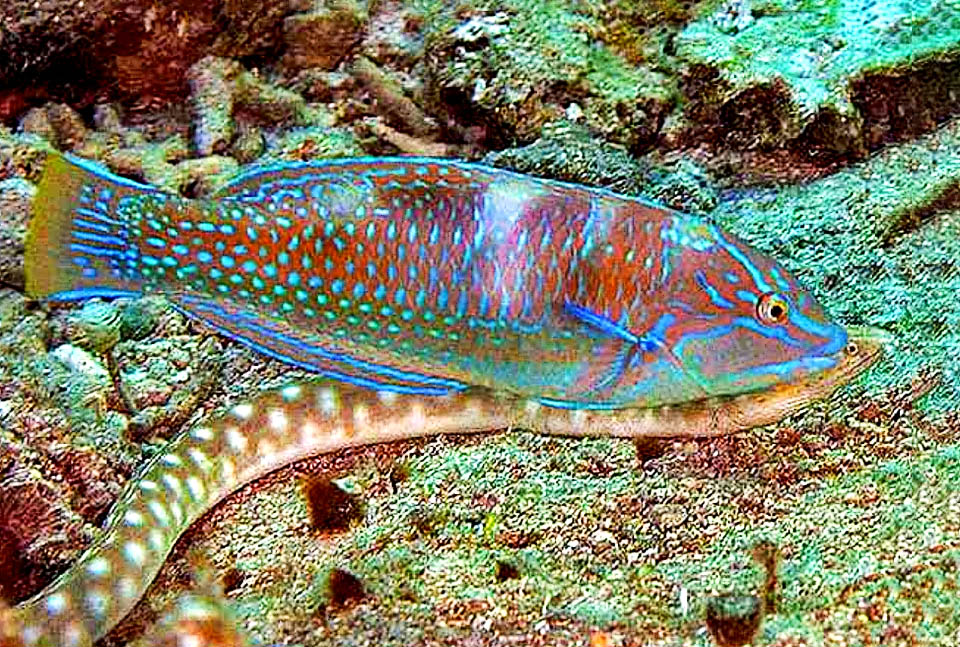
Halichoeres radiatus feeds on brittlestars, crustaceans and mollusks. To find them it follows the hunting trips of Myrichthys breviceps, a snake eel with a very strong smell © Kevin Bryant
The males own a small harem and rise to the surface with the female on duty for mating. The eggs are abandoned to the currents and also the larvae, that measure 1,7 mm upon birth, are planktonic.
The resilience of Halichoeres radiatus is low, with a minimum time for doubling the populations of 4,5-14 years and the fishing vulnerability, moderate, marks 40 on a scale of 100.
It is not fished for food purposes as the flesh is at ciguatera risk due to the presence of poisonous organisms in their diet. At most traps are set for capturing the young destined for aquarium life. Consequently, since 2008 Halichoeres radiatus appears as “LC, Least Concern” on the IUCN Red List of the endangered species.
Synonyms
Labrus radiatus Linnaeus, 1758; Julis crotaphus Cuvier, 1829; Julis cyanostigma Valenciennes, 1839, Julis opalina Valenciennes, 1839; Julis patatus Valenciennes, 1839; Iridio elegans Bean, 1906; Halichoeres irideus torquatus Parr, 1930.
→ For general information about FISH please click here.
→ For general information about BONY FISH please click here
→ For general information about CARTILAGINOUS FISH please click here.
→ To appreciate the BIODIVERSITY of BONY FISH please click here.
→ To appreciate the BIODIVERSITY of CARTILAGINOUS FISH please click here.
